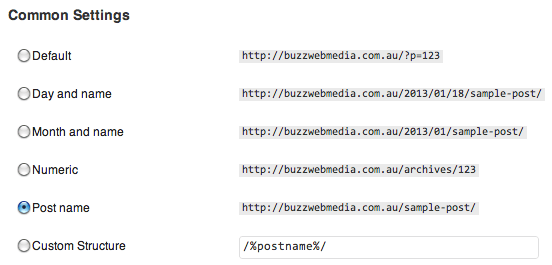WordPress has always been praised for it’s out-of-the-box search engine friendliness as a content management systems (CMS). BUT there are still some very important and basic steps you will want to take to ensure your on-site SEO is properly optimised for search engines.
This post is going to cover some of the steps when you are first setting up a WordPress site, but if you already have a WordPress site you may want to check you have set it up correctly.
1. Check Your Privacy Settings
Typically this is not something for you to worry about, but if you are using some sort of auto-installer it would be advisable to check this. WordPress has an option under Settings –> Privacy where you can set your site to “block search engines”. Having this setting on may prevent you from being indexed in search engines.

Make sure to check that the setting is set to the option that says: “Allow search engines to index this site.”.
2. Optimise The Permalinks
By default WordPress uses a very unattractive URL structure which looks something like this: http://www.yoursite.com/?p=70
For SEO and user-friendliness reasons you will want to head into Settings –>Permalinks and choose the option that says “Post Name” or enter your own custom URL structure below. This will allow you to include your keywords in the URL as it pulls the link structure from your post title, making it more readable for search engines and visitors alike.

Note: If you are changing this on an older site, WordPress will normally update your .htaccess file automatically to reflect your new permalink structure, so links to the old URLs will automatically redirect to your new URLs created by the permalink change. If you are getting 404 errors on your site then you will need to set up these redirects manually.
3. Install SEO Plugins
While WordPress is pretty good out-of-the-box, when it comes to SEO, there are a number of WordPress plugins which can be very useful in improving your site’s overall On-Page SEO.
Note: Some WordPress themes come with SEO functions built in. It is best not to use these because if you ever decide to change your theme you will need to redo everything.
All In One SEO Pack or WordPress SEO Plugin By Yoast
By default, search engines will pull the title of your post or page and description from the first few lines. An SEO plugin will allow you to easily “force” the search engines to use the meta descriptions and meta titles you want used. I’ve tried several a number of the free plugins that are available and of these I would suggest either the “All In One SEO Pack” or “WordPress SEO By Yoast“. Generally, I would lean towards “WordPress SEO By Yoast” for the fact that it does also handle some social media functions.
Google XML Sitemaps
There are two types of sitemaps that show a list of all the links on your website that you would like search engines to index. There is your sitemap that displays on a normal web page with a link to all the pages and posts on your site (there are a number of different plugins for this) which help search engine spiders crawl through your site following links. The other type is an XML sitemap which can be submitted directly to the search engines.
Google XML Sitemap is one of the best plugin for creating sitemaps. Every time a new post is written, it will automatically re-generate your sitemap and let the search engines know that the sitemap has been updated.
Automatic Interlinking of Pages & Posts
An important part of on-site SEO is effective interlinking of content between different pages on your site, e.g. linking from a post that mentions a service you offer to the page that covers that service.
I prefer to manually do this but there are plugins that will let you set the keywords and pages to link to so whenever a certain word comes up a link will automatically be inserted to the page you indicated. Automatic SEO Links is an example of such a plugin.
4. Choose An SEO-Friendly WordPress Theme
Choose a WordPress theme is also very important for SEO. Some themes do not make proper use of heading tags (h1, h2, h3, h4..), content positioning (post text should always come before the sidebar) or are simply coded so poorly the search engine bots will have trouble crawling your site properly.
Here are some things you may want to look for while choosing your WordPress theme:
- Be careful if you are choosing a free WordPress theme as a lot come with encrypted links to sites that are not related to yours and may even damage your rankings.
- All post and page titles should have the H1 tag
- Make sure H1 tag is not used in any of the header components, e.g. site title/logo, as this will result in more than one H1 tag
- Breadcrumbs navigation
- Related Posts on single posts
- Next and Previous post links
5. Add Analytics Tracking To Your Theme
This is not really part of your SEO but it is very important to watch your site usage statistics and be aware of what is working.
There are plugins that will insert tracking code (e.g. Google Analytics) into your site or there may be a field to copy and paste it into in your theme options.
Mostly, I just open up my header.php or footer.php file and insert the code manually. You will see these files under Appearance->Editor and if you are using Google Analytics there are instructions on where you should place the code).
6. Add Social To Your Site
Social signals are being factored into search engine algorithms, but even if they don’t increase your rankings, they can still generate traffic and followers. It is really easy adding social bookmarking buttons on your site, such as for Facebook, LinkedIn, Google+ & Twitter, as well as post links to your social profiles.
Just do a search and you will find all sorts of plugin options for adding social to your site.
I prefer plugins that show your social media profiles and do not just generate links to them. Remember your website is where you do your “selling” so that is where you want people to be. If they click a link and end up in Facebook , for instance, they see the red notification up the top, are distracted and then may never come back.
7. Write/Add Great Content
Ultimately the biggest factor in whether you will get traffic and have people share your site is your content. If you have content that adds value to the reader, then they are more likely to visit other pages on your site, subscribe to your site, share your site and return in the future.
Summary
So you can see that setting your WordPress on-site SEO up from the beginning is really quite simple, but it needs to be done. Once it is done all you need to worry about is writing great content and getting people to your site and sharing.
…and one final warning. Changing your permalink structure down the track, even if you set up redirects, loses all of your social signals!




